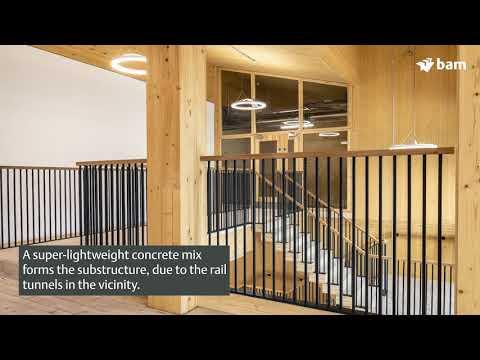King's Cross Sport Hall
The new Sports Hall in King’s Cross has a distinctive saw-tooth roof and serrated black zinc facade, which nods to its railway location and the heritage of the West Handyside canopy. The building was a complex and technical construction, being mainly constructed from glulam beams and CLT, and only 3m above live underground tunnels.
Future-proof
BAM recently completed the King’s Cross Sports Hall, but it is more than just a leisure facility – it has been designed to have multiple uses and is highly adaptable for a long lifespan. For the first two years the lower floor will serve as a location for the Construction Skills Centre, providing local people with access to training and jobs while a new facility is constructed for them. This floor will then transform into the new community sports hall for LB Camden, complementing the gym and fitness suite on the first floor.
Constructing over Victorian tunnels
The building posed some unusual challenges - it sits just above three live Victorian brickwork Network Rail tunnels serving King’s Cross Station. With the tunnels only 2-3m below the ground level, rigorous tunnel monitoring was required during construction. Precision was key, and an alert system would be triggered if the tunnels moved even 3mm. BAM’s careful methodologies and painstaking attention to detail avoided any complications.
Shared working
Just 300mm away, BAM was also constructing the building Q1 at King’s Cross. Although the two project teams had the same constraints in terms of the underground tunnels, their close proximity also offered opportunities. By the two teams working closely together they could share resources, use predominantly the same subcontractors, and were able to share learning experiences. Being in London, the two sites had logistical constraints, and this shared management approach enabled both projects to run successfully and concurrently.
Light-weight structure
The tunnels below ground also required the building to be as light-weight as possible. This was achieved through two main design decisions - timber construction and a bespoke concrete mix.
The building is primarily constructed using crosslaminated timber and a glulam frame - a light weight alternative to steel and concrete. A bespoke light-weight concrete mix containing Lytag and GGBS was used for the substructure, and runs perpendicular to the tunnels to prevent concentrated loads. The use of GGBS as an alternative to traditional Portland cement also has sustainability benefits as it is made from a by-product of iron manufacturing so has a lower embodied carbon than traditional cement.
Timber construction
The building is constructed out of 838m2 of timber, 690m3 of CLT and 147m3 glulam - all from 100% PEFC chain of custody sources.
The timber design included impressive, 22m long glulam beams and large areas of exposed cross laminated timber (CLT). The installation had to be precise as it could not be changed once installed. The CLT also proved to have its technical elements too - CLT should not be covered up unless it is under 20% moisture content. The saw-tooth design of the roof collected rainwater as soon as it was installed, so BAM came up with a vented design solution where we could install the roofing membrane and allow moisture to escape to allow the timber to dry out.
The project was nominated, and won, a Structural Timber Award 2020 for Contractor of the Year.
Waste
The use of CLT for the building envelope had many benefits in terms of waste reduction. Firstly, the CLT components were laser cut off-site using the building’s BIM model. This not only helped reduced waste on-site, but the facades were also designed to match stock cross-laminated timber (CLT) dimensions reducing waste during production too.
During construction, very minimal temporary protection was used (which normally adds to a project’s waste) and also the exposed walls and ceilings meant that there was very little off-cut waste from finishes such as plasterboard etc.
All the fixings on the building are left exposed which will mean that the building can adapt and be more easily disassembled if the needs of the building changed in the future, in line with circular principles.
Low Carbon
King’s Cross Sport’s Hall had ambitious goals – both in terms of its unique design but importantly in its target to be a ‘near-zero’ embodied carbon building. We achieved this key aspiration and the results of an embodied carbon assessment after completion proved the building has extremely low embodied carbon as well as additional sequestration benefits.
To achieve this goal, several innovative features were incorporated into the design of the building. The building uses various technologies to make it as efficient as possible to heat and cool, including natural ventilation and mechanical heat recovery ventilation, all within a highly insulated and air tight envelope (the cross laminated timber envelope contributed to excellent air permeability of 0.95m2/hr/m3 @50Pa - nearing Passivhaus territory). Carefully designed glazing also provides ample daylight to the building while reducing heat gains.
The building is connected to the King’s Cross Central District Heating System and cooling network, eliminating the need for a conventional boiler in the building and reducing in-use emissions.

